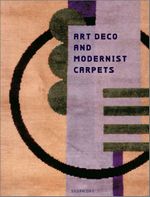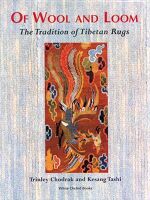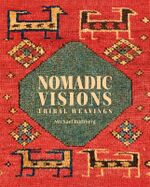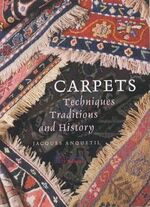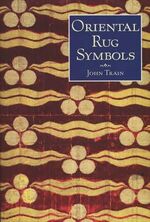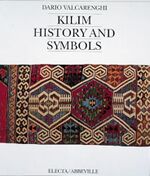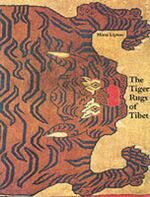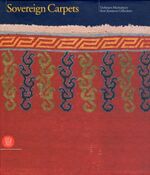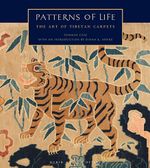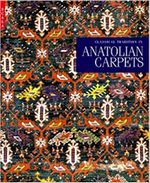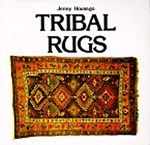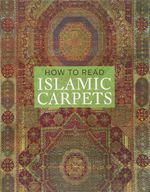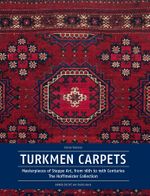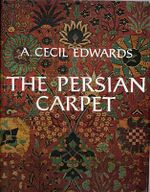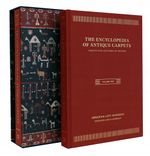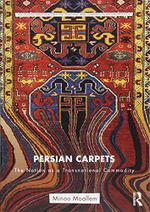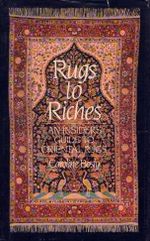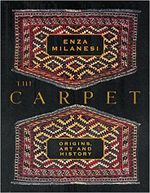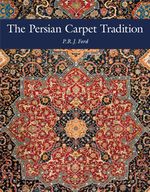WikiRug:Book of the week 2023
Week 16 2023
- week 1
Art Deco and Modernist Carpets
'Author: Susan Day
The design revolutions of the early 20th century were woven into the very fabric of the carpets and rugs of that era. Art Deco and Modernist Carpets, the first in-depth history, charts the evolution of carpet design out of the floral effusions of the Victorian salons and into the angular elegance of Art Deco and bold abstraction of Modernism popularized by the machine age. Such artists and designers as Picasso, Poiret, Gray, Delaunay, Matisse, Klee, and many more advanced the designs going on underfoot, making these rugs extremely collectible artworks in their own right. Generously sized and beautifully illustrated with over 250 full-color photographs, here are Art Deco and Modernist carpets at their most glorious.
- week 2
Of Wool And Loom: The Tradition Of Tibetan Rugs
Author: Trinley Chodrak
Offers a history of Tibetan carpet and textile weaving, traces the growth of Tibet as a commercial carpet-weaving center, and discusses the steps involved in learning the art of weaving.
- week 3
Der Handgeknupfte Teppich: Ein Umfassender Aktueller UEberblick UEber Handgemachte Teppiche
Author: Fritz Langauer
A lavishly illustrated book shows how traditional handmade rugs and carpets have become vehicles for contemporary trends and used in interior design and home decoration. The authors' work in journalism and rug production over the last fifty years equips them with the experiences of the travel writer and the specialist knowledge of leaders in the global rug market.
The developments in the weaving industry in India, Iran, Turkey, China, Turkmenistan, Morocco, Pakistan, and Afghanistan are reviewed as well as the historical and cultural context for change in a book that shines a light on the contemporary rug market in the 21st century.
- week 4
Nomadic Visions: Tribal Weavings from Persia and the Caucasus
Author: Michael Rothberg
The Michael and Amy Rothberg Collection of knotted-pile tribal and nomadic bags and other rare small format pile weavings, among them many pieces made for women's dowries and other ceremonial functions, is recognized as the best of its kind anywhere in the world. The collection has been carefully and thoughtfully assembled over the past four decades.
- week 5
Carpets: Techniques, Traditions and History
Author: Jacques Anquetil
A guide for those interested in understanding the stories and legends told within traditional hand-knotted 20th-century carpet design. Every sequence of knots has almost infinite possibilities as a language for recounting history, mythology, religious illusions, and ancient civilizations.
- week 6
Oriental carpets, from Turkey and Persia in the Middle East to China in the Far East, are amazingly rich in symbolism. This fascinating book will delight and enlighten everyone who enjoys oriental carpets.
- week 7
Kilim: History and Symbols
Author: Dario Valcarenghi
This volume illustrates 160 rare kilims, explains in detail their history and craftsmanship and discusses the symbolic meaning of their decorative motifs. The book is also illustrated with original drawings that should enable the reader to recognize and interpret the various kilim typologies.
- week 8
Tiger Rugs of Tibet
Author: Mimi Ed Lipton
This book reproduces 108 of the various designs, illustrated in color and accompanied by four essays. Philip Goldman contributes an ethnological exploration on the subject of tigers. Cyril Barrett analyses the visual aspects of the rug designs. Jim and Barbara Ford examine the techniques of Tibetan carpet making. Finally, Tom Philips recounts his recent discovery of the world of tiger rugs.
- week 9
Sovereign Carpets
Author: E Concaro
The book illustrates the extraordinary and very ancient art of rugs with a relevant selection of Oriental rugs--from the oldest to the ones produced in the late 19th century--belonging to European private collections, besides a set of rugs coming from the Russian ethnographic museum of St. Petersburg. The fruit of long research within the rich private artistic patrimony, the catalog assembles two hundred Oriental rugs from the 15th to the 19th century, coming from Persia, Anatolia, the Caucasus, Central Asia, Tibet, Turkestan, and China.
- week 10
Patterns of Life: The Art of Tibetan Carpets
'Author: Thomas Cole
Tibetans have used carpets for decorative and functional purposes, favoring colorful dyes and lively designs to enrich their homes and monasteries. Not bound by the codified rules governing the creation of religious art, the artisans who wove carpets often demonstrated a delightful sense of imagination in their work, drawing inspiration from a wide range of sources. Carpet motifs such as medallions and checkerboard patterns suggest considerable influence from Tibet's historical textile trading partners, countries as close as China and as distant as Iran. Other popular imagery, such as the snow lion, is indigenous to the region. With exceptional examples of saddle rugs, sleeping rugs, pile pillows, cushion covers, and door rugs, Patterns of Life explores the stylistic variety and uses of Tibetan carpets in the everyday life of the Tibetan people.
- week 11
Carpets and Rugs of Europe and America
'Author: Sarah B. Sherrill
In this comprehensive volume, Sarah Sherrill examines Western carpet design and production from the Middle Ages to the present, in styles that range from magnificent palatial creations to delightful folk designs. With hundreds of dazzling illustrations, Sherrill's authoritative text includes chapters on Moorish weavers and the golden age of carpets in Spain; the exquisite carpets of the Savonnerie, Aubusson, and Beauvais in France; productions from Moorfields, Exeter, and Axminster in England; the intriguing but little-studied rugs of Eastern European countries; the charming and resourceful rugs of America; and an important chapter on modern designs that offers an extensive survey of rugs created by leading artists and architects of the nineteenth and twentieth centuries. Sherrill's stimulating text, based on years of research, brims with interesting new findings, not only on the history and design of these works, but also technological developments that had an often unrecognized effect on rug design and production.
- week 12
Qarajeh to Quba: Rugs and Flatweaves
'Author: Raoul E. Tschebull
This book features the collector/author's well informed views about a careful selection of mainly 19th century knotted pile carpets and flatwoven covers in various techniques from his own extensive collection, which has been built up over a period of more than five decades. Many of the rugs, which are all of the highest graphic and artistic quality, have been acquired without recourse to the open market and are therefore previously unseen and unpublished. Raoul (Mike) Tschebull's long experience in the genre allows insights that go beyond the conventional wisdom of the traditional antique oriental carpet bazaar. His collecting career began under the aegis of one of the great US collectors of a previous generation, Joseph V. McMullan.
- week 13
Stars of the Caucasus: Silk Embroideries From Azerbaijan
'Author: Michael Franses
Published on the occasion of an important international loan exhibition at The Azerbaijan National Museum in Baku, this multi-author book is much more than a mere catalog. Containing previously unpublished research and a wealth of previously hidden material from museums and private collections around the world, and written by a team of international museum professionals and independent scholars, it is the first coordinated and detailed study of the West Caspian region's characteristic silk embroideries. The book traces the history of embroidery in the Caucasus, the multi-cultural sources of domestic embroidery, iconography and designs in which the textile traditions of the Iranian and Turkic worlds meet, materials and needlework techniques, as well as the relationship between embroidery and the pile carpet weaving tradition in the region.
- week 14
Classical Tradition in Anatolian Carpets
'Author: Walter B. Denny
Denny draws on the unparalleled collection at Washington's Textile Museum, as well as from other museums and private collections, dealing with issues such as history, lineage, design origins and meaning across the whole spectrum of Turkish carpet weaving.
A fresh and concise look at Anatolian carpets from the 14th to the 20th centuries, including some of the oldest surviving examples of Turkish carpets. Turkish rugs have been a part of European culture since the 14th century. Far more embedded in the Western consciousness than any other carpet type, they are among the most sought-after of all rugs by museums and collectors today.
- week 15
Caucasian Carpets and Covers: The Weaving Culture
'Author: Richard E. Wright, John T. Wertime
Caucasian Carpets & Covers is the first book to offer a comprehensive view of nineteenth and twentieth century knotted pile rugs and flat-woven textiles from Caucasia in the light of recent research. Written by two acknowledged experts in the field, the text is securely based on original written and photographic sources, coupled with a systematic analysis of woven structures. The collapse of the Soviet Union and the consequent opening up of communication and trade between the West and the newly independent Caucasian republics has resulted in the release onto the market of previously little known items, in particular flat-weaves. This development calls for a re-evaluation of the subject of Caucasian weaving, a demand which this book seeks to answer. The authors suggest that utilitarian flat-woven covers and containers - many of them spectacularly graphic and colourful - are the true traditional products of Caucasia's weaving culture.
- week 16
Tribal Rugs: An Introduction to the Weaving of the Tribes of Iran
'Author: Jenny Housego
This book is regarded as the most authoritative work on tribal rugs. The colorful way of life, often associated with its arduous and ancient patterns of migrations through rugged and spectacular landscapes, forms the backdrop of this much needed book.This book paints a fascinating picture, not only showing superb examples of tribal rugs but also the way in which they are woven and the life of the tribes themselves.The author's many years of study and close association with the tribespeople responsible for these stunning rugs and fabrics enables her to speak with authority, not only about well-known groups such as the Qashqa'i of southwest Iran, the Baluch of the southeast, the widespread Kurds and the Turkoman, but also such important weaving groups as the Shahsavan of the north regions.In short, Jenny Housego is able to describe the rich elements in the design as well as giving technical notes on the weaving so that the text and pictures together form an essential introduction for anyone who knows or cares about rugs.
- week 17
Oriental Rug: The Carpets of Afghanistan
'Author: R. D. Parsons
Richard Parsons treats the reader to not only a veritable feast of carpets and rugs but also to a fascinating journey through the history of a diverse, colorful, multi-racial country. He shares his respect and admiration for Afghanistan's stoical people, who somehow, despite political upheavals, forced resettlement, a harsh climate, and often primitive nomadic living conditions, manage to produce exquisite works of art which reflect great pride in their many-faceted heritage. Afghan rugs are instantly appealing due to their traditional colors and bold designs, from sumptuous piled purdahs to flat-woven prayer rugs.
- week 18
How to Read Islamic Carpets (The Metropolitan Museum of Art - How to Read)
'Author: Walter Denny
Carpets made in the “Rug Belt”―an area that includes Morocco, North Africa, the Middle East, Central Asia, and northern India―have been a source of fascination and collecting since the 13th century. This engaging and accessible book explores the history, design techniques, materials, craftsmanship, and socioeconomic contexts of these works, promoting a better understanding and appreciation of these frequently misunderstood pieces. Fifty-five examples of Islamic carpets are illustrated with new photographs and revealing details. The lively texts guide readers, teaching them “how to read” clues present in the carpets. Walter B. Denny situates these carpets within the cultural and social realm of their production, be it a nomadic encampment, a rural village, or an urban workshop. This is an essential guide for students, collectors, and professionals who want to understand the art of the Islamic carpet.
- week 19
Turkmen Carpets: Masterpieces of Steppe Art, from 16th to 19th Centuries The Hoffmeister Collection
'Author: Elena Tsareva
The Hoffmeister Collection is one of the best and most extensive private collections of antique and historic Turkmen knotted carpets in Western Europe and America. It competes alongside important collections from Western museums as well as those in Russia and Turkmenistan. With almost 200 objects - among which are distinguished carpets and bags - artistic excellence and historical significance come together. As one of the first to do so, Hoffmeister has determined the age of these knotted works of the Turkmen with the aid of radio-carbon techniques. According to the results from the science and technology university ETH in Zurich, the earliest pieces of the collection originate from the sixteenth century.
Both the cultural significance of the collection and the scientific and artistic value of its pieces are discussed in this book. The readers can really sense the texture of these knotted wares through the brilliant photography, which carry them away on a journey into the lost world of the Steppes folk of Central Asia.
- week 20
The Persian Carpet: A Survey of the Carpet-Weaving Industry of Persia
'Author: A. Cecil Edwards
Edwards, a leading figure in the rug business, rose to the top of his profession and became managing director of the legendary Oriental Carpet Manufacturers based in Turkey. In this unique book, containing over four-hundred images and an eight page color plate section, he shares his invaluable knowledge and takes the reader on a diverse and colorful journey through history, showcasing the vast range of carpets woven in Persia from 1850 through to the twentieth century. He explores the rich diversity and elaborateness of colors and designs available, from the traditional to the more modern and explores regional variations, styles, and terminologies. Inside these pages you will find detailed information on different symbols and motifs, discussions on knots, weaving and dyeing, and what to look for in terms of quality. Presented in an informative and accessible style, Edwards' love of the product and the industry shine through in his writing, presenting the reader with expert advice and knowledge as well as painting a fascinating cultural and historical landscape. This is a timeless book presented in a beautiful new package, and is a must-have for anyone interested in Persian carpets.
- week 21
The Encyclopedia of Antique Carpets: Twenty-Five Centuries of Weaving
'Author: Abraham Levi Moheban
This book diverse forms that the art and craft of the handwoven carpet has taken over twenty-five centuries, from the Far East to North Africa, from Europe to India, and within both hemispheres of the New World. The book features Classic Asiatic sources in the "Rug Belt"—Persia (Iran), Anatolia (Turkey), the Caucasus, China, India, and central Asia—and includes more than six hundred entries on all areas of historic carpet production, ranging from village to city and style to weaver. Each entry provides a photograph and information on the history, location, weaving period, technique, quality, design, coloration, size, and marketability of carpets produced around the world. This beautiful clothbound, two-volume boxed set is a comprehensive collection that is required reading for anyone with an eye on the antiques market or the cultural heritage of one of the oldest forms of artwork.
- week 22
Persian Carpets (Routledge Series for Creative Teaching and Learning in Anthropology
'Author: Minoo Moallem
The Nation As a Transnational Commodity tracks the Persian carpet as an exotic and mythological object, as a commodity, and as an image from mid-nineteenth-century England to contemporary Iran and the Iranian diaspora. Following the journey of this single object, the book brings issues of labor into conversation with the politics of aesthetics. It focuses on the carpet as a commodity which crosses the boundaries of private and public, religious and secular, culture and economy, modern and traditional, home and diaspora, and art and commodity to tell the story of transnational interconnectivity.
- week 23
One Hundred Years of Navajo Rugs
'Author: Marian E. Rodee
This history of Navajo weaving is a revised, expanded, and updated version of Marian Rodee's 1981 classic Old Navajo Rugs: Their Development from 1900 to 1940. Designed for the general reader, museum goer, or collector, it offers a guide to identifying and dating rugs by means of weaving materials. Wool quality, the author explains, is the single most important clue to the date of a rug's manufacture. Rodee also provides historical background on the great Navajo weavers and especially on the traders who bought rugs from the Navajo--Cotton, Moore, Hubbell, Bloomfield, McSparron, and others--all of whom had some influence on the development of the craft and patterns of Navajo weaving.
Since the first edition of this book, more information about more collections of rugs has become available, and this new edition includes a greatly expanded section of color plates in addition to sixty-four black-and-white photographs. Rodee has also added a map of the Navajo Nation showing the location of trading posts and outlet stores.
- week 24
The Splendor of Antique Rugs and Tapestries
'Author: Parvis Nemati
For centuries, the design woven into Oriental rugs and the distinctive artistry of each rug-weaving area has reflected an uninterrupted cultural and historical tradition. The Splendor of Antique Rugs and Tapestries celebrates this glorious tradition in its sumptuous presentation of the remarkable achievements of weaving from the Oriental and Occidental world.
Parviz Nemati believes that handmade carpets and tapestries are the most expressive works of art that have ever been created. Following a history of rug making and an explanation of the techniques and materials used, the characteristics of Persian, Turkish, Caucasian, Turkmen, Indian, Chinese, and European rugs and tapestries are richly illustrated and described through 300 color plates and an authoritative text that explores the heritage of both Oriental and European weaving.
- week 25
An Illustrated Guide to Making Oriental Rugs
'Author: Gordon W. Scott
This book takes the mystery out of this centuries-old art form by illustrating, in detailed steps, how to build a loom and handknot a rug as fine and intricate as those originating in the Middle East and the Orient. This unique book is a comprehensive self-instruction manual, written for both the diligent beginner and the experienced weaver, as well as the needlepoint devotee searching for challenging new designs.
- week 26
Rugs to Riches
'Author: Caroline Bosly
Rugs to Riches is an authoritative, lively, and eminently practical guide for people who want to learn the dos and don'ts of choosing handmade oriental rugs. Caroline Bosly, one of the foremost rug brokers in the world, describes the various types of rugs and their origins, explains the difference between buying new and antique rugs, and tells you how to buy a rug of any size at the best possible price. Written in a simple, straightforward style that strips away the mystique from oriental rugs, Rugs to Riches also advises you on:
Determining whether a rug is handmade or not, and whether it has been altered in any way.
Evaluating a rug's condition and determining whether the retail price is a fair one, using a simple point system.
Bargaining down the price of a rug, no matter what type of store you find it in.
Selling a rug and making a profit.
Decorating with oriental rugs and ensuring that they remain clean and in good repair.
- week 27
Knots: Art & History: The Berlin Carpet Collection
'Author: Anna Baselin
The Museum of Islamic Art in Berlin boasts one of the oldest collections of Islamic Art in Europe, and an incomparable collection of some 500 knotted carpets from the Islamic world. Knots: Art & History presents a selection of 45 of the best, most unique carpets in that collection, illustrated in stunning detail. Featuring objects made from the 14th through the 17th centuries in Spain, Egypt, Anatolia, the Ottoman Empire, the Caucasus, Persia and India, this publication shows the breadth and depth of the Berlin collection.
The selected carpets narrate the collection’s own eventful history, from the early 20th-century birth of European research into Islamic Art and Wilhelm von Bode’s foundation of the museum through the Cold War–era division of the collection and its 2001 reunification. This volume presents the Berlin Museum’s reunited carpet collection for the first time in English.
- week 28
WikiRug:Book of the week/2023/28
- week 29
WikiRug:Book of the week/2023/29
- week 30
Weavings of Nomads in Iran: Warp-faced Bands and Related Textiles
'Author: Fred Mushkat
There is a rich tradition of hand-woven bands made by the nomadic pastoralists of Iran. They have a large and detailed design vocabulary and were executed using weaving skills that were not exceeded by any other weaving tradition. No study of nomadic life and weavings in Iran is complete without them. Among Qashqa'i tribal weavers in particular, the warp-faced bands used to attach loads to pack animals were a key symbol of their nomadic life. These bands carry a large repository of motifs that may be a source of archaic design elements. Bands illustrate a connection between and among groups of nomadic pastoralists, as great distances may have separated their ancestors for hundreds of years. Although the overwhelming majority of weavers were illiterate, they possessed a different form of literacy in which they were capable of transferring an image into a woven structure. This is the first book devoted exclusively to these weavings.
Contents: Introduction; The Functions of Warp-faced Bands in Nomadic Life; Structure and Construction; Buckles & Fastening Systems on Bands; Dating Textiles; Design & Structural Changes on Nineteenth and Twentieth-Century Warp-faced Bands; Imagery & Design Elements; Tribal Confederacies; Plates; Bands, Ropes, Braids, and Tassels among Qashqa'i Nomads; Glossary; Bibliography.
- week 31
The Carpet: Origins, Art and History
'Author: Enza Milanesi
From the perspective of Western culture, it is not always easy to understand the complexities of the antique Oriental carpet. Part of the fascination lies in its dual nature as a simple, even humble artifact intended to be used in a variety of ways as well as a sophisticated artistic object with ancient designs unfamiliar to us. Providing the tools to understand the decorative and technical aspects of a carpet, including its geographic area of production, The Carpet: Origins, Art and History is a handsome reference book for lovers of art and antiques who are eager to deepen their knowledge of this intriguing world. Intentionally neither a manual nor a guide, this book aims to inform and captivate.
The Carpet celebrates its subject with clear and concise text as well as photographs and design diagrams that illustrate the most important ancient carpets. The stunning photographs capture the beauty and intricacy of this extraordinary art and play an important role in the critique and analysis of the various carpet specimens. With diagrams and drawings, this book provides an inspiring study of the carpet in all its dimensions, from decoration and its interpretation to the layout system, the ornamental motifs and their symbolic meaning and origin.
- week 32
WikiRug:Book of the week/2023/32
- week 33
WikiRug:Book of the week/2023/33
- week 34
WikiRug:Book of the week/2023/34
- week 35
The Persian Carpet Tradition
'Author: P. R.J. Ford
This book describes between 1400 and 1500 a design revolution in Persia swept away a 2000-year-old tradition of carpet design, replacing abstract geometric patterns with complex floral scrolls dominated by a central medallion derived from the Chinese cloud-collar shape. This revolution represents a major event in world art history, comparable to that which occurred at the same time in Renaissance Italy. It was followed over the next four centuries by a second revolution, during which the principal design elements of the first permeated carpet production at every level throughout Persia and continue to dominate it to this day.
- week 36
WikiRug:Book of the week/2023/36
- week 37
WikiRug:Book of the week/2023/37
- week 38
WikiRug:Book of the week/2023/38
- week 39
WikiRug:Book of the week/2023/39
- week 40
WikiRug:Book of the week/2023/40
- week 41
WikiRug:Book of the week/2023/41
- week 42
WikiRug:Book of the week/2023/42
- week 43
WikiRug:Book of the week/2023/43
- week 44
WikiRug:Book of the week/2023/44
- week 45
WikiRug:Book of the week/2023/45
- week 46
WikiRug:Book of the week/2023/46
- week 47
WikiRug:Book of the week/2023/47
- week 48
WikiRug:Book of the week/2023/48
- week 49
WikiRug:Book of the week/2023/49
- week 50
WikiRug:Book of the week/2023/50
- week 51
WikiRug:Book of the week/2023/51
- week 52
WikiRug:Book of the week/2023/52
- week 53
WikiRug:Book of the week/2023/53
